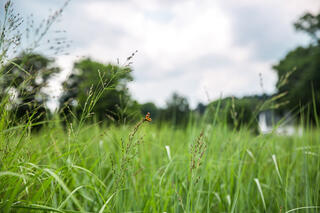Nitrogen cycling in switchgrass varieties

Multiple switchgrass varieties sustain high yield under minimal fertilizer application.
The Science
Nitrogen is an essential nutrient for plants. In ecosystems with limited nitrogen, plants must either develop strategies to conserve it or fertilizer must be added to help plants grow. Switchgrass is a perennial grass with two distinct ecotypes (upland and lowland) that grows well in soils with low nitrogen. Great Lakes Bioenergy Research Center (GLBRC) scientists measured the growth and nitrogen cycling of 12 cultivated varieties of switchgrass to understand the strategies that different cultivars use to acquire and conserve nitrogen. Results suggest substantial nitrogen cycle differences in switchgrass that could be harnessed to create new or improved high-yielding, nitrogen-conserving cultivars.
The Impact
Fertilizer often used to provide nitrogen for plants to grow comes with economic and environmental costs. Understanding nitrogen efficiency traits in switchgrass will help to determine which varieties require less fertilizer, improving the crop’s economic and environmental value. Differences in nitrogen conservation and acquisition capacities between the switchgrass varieties suggest potential for a genetic explanation of these traits that can be then used to produce high yielding varieties that use nitrogen efficiently.
Summary
High yielding switchgrass varieties that require minimal nitrogen fertilization are crucial to bioenergy research because of their economically and environmentally sustainable qualities. Switchgrass, like other perennial grasses, extracts nitrogen from soils by growing long roots and by forming relationships with root fungi. Switchgrass also associates with microbes that can fix nitrogen, i.e., take up nitrogen from air and convert it into a compound plants can use to grow. Additionally, by conserving nitrogen in perennial roots, switchgrass reduces its annual nitrogen requirements. GLBRC researchers studied how nitrogen acquisition and conservation varies in 12 switchgrass varieties.
Switchgrass lowland ecotypes that thrive in wet, marshy areas and in southern climates had higher yields, nitrogen translocation, and root nitrogen fixation, while upland ecotypes that grow on ridgelines and prairie areas in states such as Michigan had higher soil nitrogen fixation. The differences within switchgrass varieties was likely due to their phenology, physiology, and microbial community composition. Lowland ecotypes conserved more nitrogen in their tissues likely due to the longer growth period in lowland than in upland ecotypes. Differences between soils and roots suggest that varied factors influence root and soil microbiomes. Roots are a more direct path for nitrogen uptake because of physical proximity, so roots had higher nitrogen fixation rates, probably due to their higher abundance of common nitrogen fixers. Despite greater nitrogen fixation in roots, soil has more volume and thus, on an ecosystem basis, contributes more nitrogen to plants. The variety and ecotype differences in nitrogen fixation were independent of soil nitrogen and moisture suggesting the differences in soil nitrogen fixation could be due to the differences in microbiome or in soil C composition and availability.
Program Manager
N. Kent Peters
Program Manager, Office of Biological and Environmental Research
kent.peters@science.doe.gov, 301-903-5549
Corresponding Authors
Sarah S. Roley
Assistant Professor, Washington State University
sarah.roley@wsu.edu, (509) 372-7449
G. Philip Robertson
University Distinguished Professor, Michigan State University
robert30@msu.edu, (269) 760-8364
Funding
Support for this research was provided by the Great Lakes Bioenergy Research Center, U.S. Department of Energy, Office of Science, Office of Biological and Environmental Research (DE-SC0018409), by the National Science Foundation Long-term Ecological Research (1832042) and Division of Environmental Biology (1754212) programs, and by Michigan State University AgBioResearch.
Publications
Roley, S.S., Ulbrich, T.C., and Robertson, G.P., “Nitrogen fixation and resorption efficiency differences among twelve upland and lowland switchgrass cultivars,” Phytobiomes 116, 071802 (2020). [DOI: 10.1094/PBIOMES-11-19-0064-FI]
Related Links
https://apsjournals.apsnet.org/doi/10.1094/PBIOMES-11-19-0064-FI